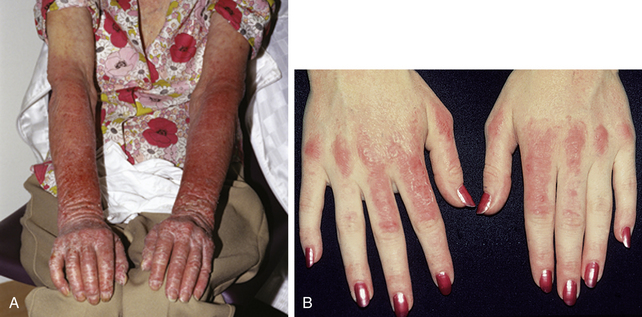Chapter 17 Photosensitive dermatitis

Figure 17-1. Phototoxic drug eruption. Sunburn-like erythema on the cheeks, neck, V-area of the chest, and dorsal forearms.
A photoallergic reaction only occurs in sensitized individuals when electromagnetic radiation (usually ultraviolet light, but sometimes visible light) interact with an endogenous (Fig. 17-2A) or exogenous (Fig. 17-2B) chemical, converting it to an allergen that the person’s immune system recognizes as an allergen (requires more than one exposure). Photoallergic reactions typically occur 1 to 3 days after exposure (with the exception of solar urticaria, which is immediate). Phototoxic reactions tend to be well demarcated in the areas of exposure. Photoallergic reactions are also photodistributed, but often have extension of the cutaneous reaction onto covered areas or even distant sites in an autoeczematous type of eruption. Sometimes chemicals may produce both a phototoxic and photoallergic phenomenon.
Table 17-1. Topical Agents Causing Phototoxic and Photoallergic Reactions
| PHOTOTOXIC CHEMICALS | PHOTOALLERGIC CHEMICALS |
|---|---|
| Benzocaine Benzoyl peroxide (UVB) Coal tar Erythromycin Halogenated salicylanilides Hydrocortisone Ketoprofen Porphyrins (visible light and UVB) Psoralens |
Sunscreens: oxybenzone, benzophenone, etc. Fragrances: methylcoumarin, musk ambrette, sandalwood oil NSAIDs Oxicams: ampiroxicam, droxicam, meloxicam, piroxicam, tenoxicam Prioprionic acid derivatives: benzophenone, dexketoprofen, ketoprofen, piketoprofen, suprofen (UVA and UVB), tiaprofenic acid, diclofenac Antimicrobials: bithionol, chlorhexadine, fenticlor, hexachlorophene Phenothiazines: chlorpromazine, promethazine Miscellaneous Acyclovir Dibucaine Halogenated salicylanilides (UVA and UVB) Hydrocortisone |
Table 17-2. Systemic Agents Causing Phototoxic and Photoallergic Reactions
| PHOTOTOXIC | PHOTOALLERGIC |
|---|---|
| Antimicrobials Tetracyclines: demeclocycline, dimethylchlorotetracycline, doxycycline, lymecycline, minocycline, tetracycline Quinolones: ciprofloxacin, enoxacin, fleroxacin, levofloxacin, lomefloxacin (UVA and UVB), nalidixic acid, pefloxacin, sparfloxacin Griseofulvin Voriconazole Sulfur-containing medications: bumetanide, furosemide, hydrochlorothiazide, sulfonamides (UVB), sulfonylureas NSAIDs: proprionic acid derivatives: benzophenone, carprofen, ketoprofen, nabumetone, naproxen, suprofen (UVA and UVB), tiaprofenic acid Antimalarials: chloroquine unknown, hydroxychloroquine (UVB), quinidine Miscellaneous: amiodarone, atorvastatin (UVB), calcium-channel blockers, chlorpromazine, prochlorperazine, porphyrins (UVB and visible), psoralens, retinoids (UVA and UVB), St. John’s wart (hypericin) |
NSAIDs: piroxicam, celecoxib, ketoprofen Sulfur-containing medications: hydrochlorothiazide, sulfacetamide (UVB), sulfadiazine (UVB), sulfapyradine (UVB), sulfonamides (UVB), sulfonylureas Antimalarials: chloroquine unknown, hydroxychloroquine (UVB), quinidine, quinine Antimicrobials: chloroamphenicol unknown, enoxacin, lomefloxacin (UVA and UVB), sulfonamides Griseolfulvin Phenothiazines: chlorpromazine, dioxopromethazine, perphenazine, thioridazine Miscellaneous: amantadine, dapsone unknown, diphenhydramine (UVB), flutamide (UVA and UVB), pilocarpine, pyridoxine, ranitidine |
Key Points: Photosensitive Dermatitis

Figure 17-4. Polymorphous light eruption. Erythematous, scaly plaque on the lateral neck, which tended to recur each spring.
Dummer R, Ivanova K, Scheidegger EP, Burg G: Clinical and therapeutic aspects of polymorphous light eruption, Dermatology 207:93–95, 2003.
Murphy GM: Diagnosis and management of the erythropoietic porphyrias, Dermatol Ther 16:57–64, 2003.















